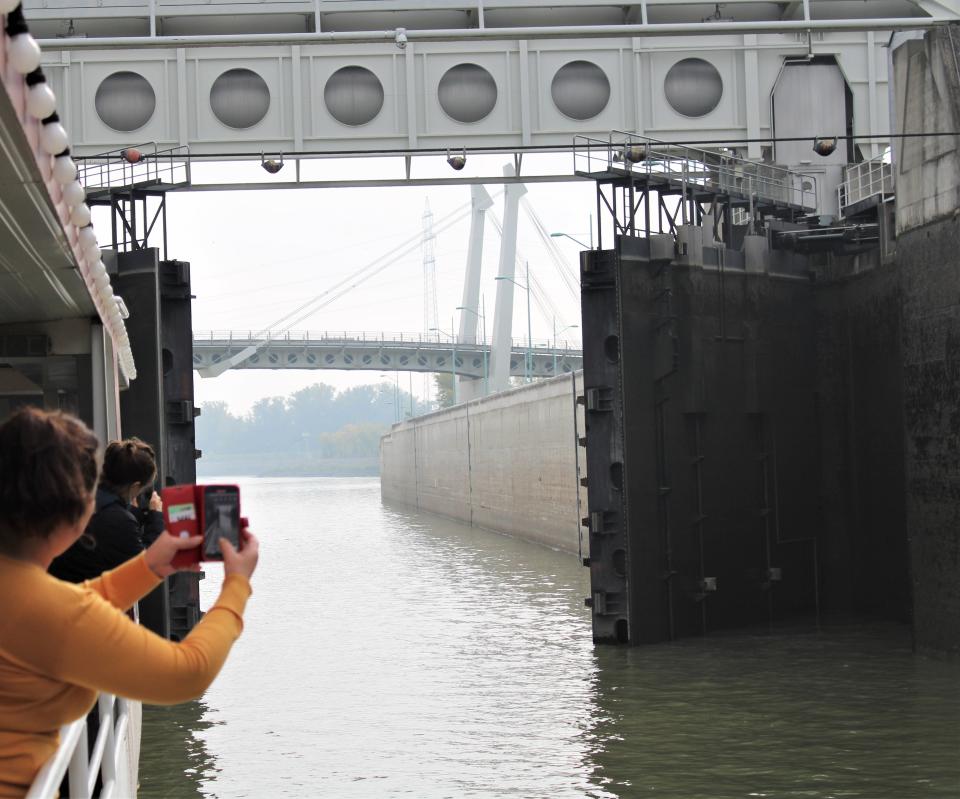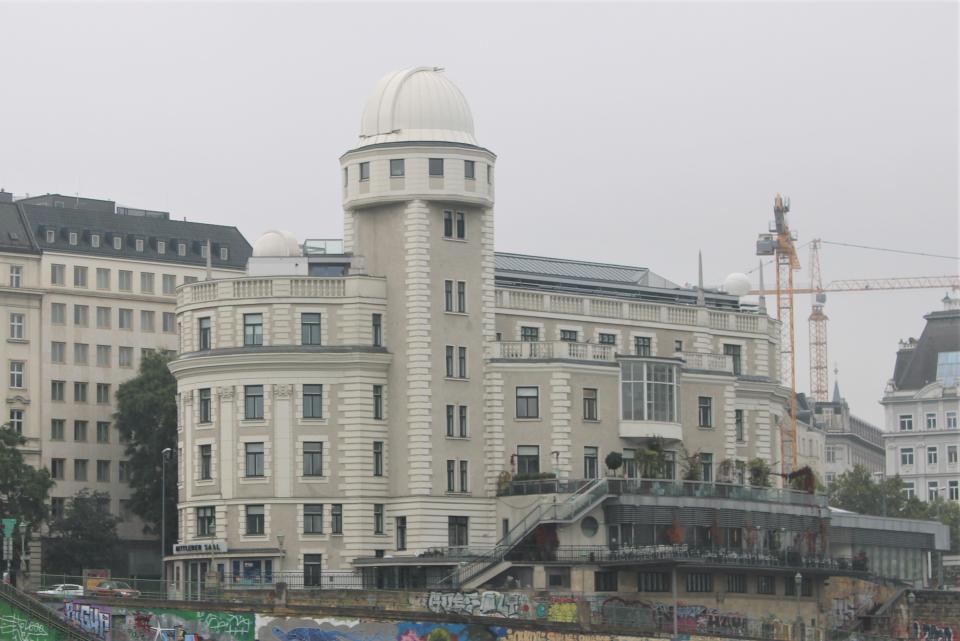Views of Vienna unforgettable on the Danube

Laureen was busy pouring over a stack of tourist pamphlets in the small apartment we had rented for our stay in Vienna.
It was a lovely spot called MyPlace, located along Vorlaufstrasse in the city center of Austria’s capital city.
I liked the name.
“Where’d you stay in Vienna?”Vi
“My place,” I would answer, with a touch of a Viennese accent.
“Must be nice to have your place.”
“It was,” I said with a slight bow, showing my gracious side.
The weather had not turned out to be what we had expected, much like whenever travelers travel. It was supposed to be raining and cold much of the time as we trouped about the city of nearly two million folks.
The 20 suitcases Laureen had packed for the trip were loaded to their bulging zippers with winter jackets, rain jackets, jackets with two pockets, jackets with hoodies, and jackets within jackets.
The Nanook of the North wardrobe was not necessary for this outing. We could have worn shorts and tank tops most days. Thank goodness there were 19 other suitcases for this eventuality.
“How about a lunch cruise along the Danube?” Laureen asked.
“I like boats,” I said. “But only if lunch includes schnitzel. Has to have schnitzel or count me out.”
She nodded. “It does, and it’s three hours of sightseeing along the river.”
Something about a three-hour cruise gave me pause for a moment.
“Gilligan will not be aboard,” Laureen said.
We donned our yachting gear. Blue jeans, a t-shirt, sneakers, and a light sweatshirt in case the sun disappeared behind a silly cloud or two during the river trip.
The Danube is the second longest European river: 1,770 miles of blue flowing water starting in Germany and passing through ten countries before emptying into the Black Sea. The Volga in Russia is longer by approximately 400 miles but only travels through one country, so who cares?
We were going to be eating schnitzel on the Danube.

Our ship was to be the DDSG Blue Danube for the lunch cruise. I have no idea what DDSG stands for, though – I asked around at the docks but was only met with a couple of salty crew members who prattled something in German.
I smiled and believed they had said something about my shoe being untied. I looked; it wasn’t.
One of the captains, Matthia S. Krista, is quoted as saying. “As one of the most livable cities in the world, Vienna is always worth a visit. For tourists as well as for locals who want to enjoy the view from the water. I am pleased to be able to look after you safely on board our ships.”
In all transparency, I lifted that quotation from the company’s website.
Arriving dockside along the Schwedenplatz in the Danube Canal area, we were greeted by amiable crew members who reminded us not to fall while boarding.
“That warning ruined my day already,” I said.
The Blue Danube, our cruise ship, was long and spacious, with two decks: the top view deck on top and the bottom view deck on the bottom.
No sooner had we taken a beautiful spot on the top deck with our table and fabulous views of the river and the city than our waiter appeared as if by magic.
It was Vienna, after all.
“Could I interest you in a beverage before we depart?”
Ah, Vienna.
Like trains in Europe, the cruise started right on time — punctuality is greatly admired and adhered to by Europeans. As the dock lines slipped off the port and the bow thrusters churned away in the fast currents of the Danube, I looked at my watch.
“Right on time.”
“I have three minutes past the hour,” Laureen replied.
“American time, I’m on Austrian time.”
The river is wide, plenty wide enough to accommodate a couple of ships the size of the Blue Danube, which could easily pass each other if needed. There wasn’t, and it was more than an hour before any other boats came into view.
What was in view were beautiful sights of the city as we drifted by.

One of the first sights was the Urania observatory, the oldest observatory in Vienna, built-in 1910. During World War II, the observatory’s dome, along with some of the more fragile astronomical equipment, was destroyed by Allied bombings. In 1957, the observatory was reopened to the public.
Green trees lined the shorelines of the Danube River, and as we gently cruised, we got a taste of what it would be like living along a real river.
The Mojave River may be a river, but I do not foresee any cruise ships powering by Apple Valley, Victorville, or Hesperia anytime soon.
“Look, mom,” a young tike on a Mojave river cruiser may say. “Is that water I see in the river?”
“No, you are thinking of the Danube.”
The Romans called the river the Danubius, an ancient Celtic word meaning, appropriately, to flow, and was shortened during modern times to simply the Danube.
History has flowed along the stretches of this waterway for eons. As water transportation played a powerful role in empires, as it still does today, many historical figures have ventured the width and length of the river Danube.
In 1529, the Ottoman Empire, after crushing Hungary, ventured to the city of Vienna along the Danube and laid siege. But after two short weeks, the Ottomans gave up and left the territory. The Sultan, Suleiman the Magnificent, had over 100,000 soldiers against the defending Viennese army of only 21,000.
Rumor has it that Suleiman the Magnificent blamed the failure on his younger brother, Ahmet the Mediocre.

Following the dismal siege, another 150 years of constant rivalry would erupt between the Ottoman Empire and the Hapsburg Dynasty in Austria.
Soon, we entered the Freudenau lock not far from Danube Island, along the Danube Canal. We had never been in a lock before, and it was exciting.
Note: we need to get out more.
The locals refer to the Freudenau lock as the largest bathtub in Vienna. It is huge, containing more than 80,000 cubic meters of water.
I have no idea what that means, but a lot of water is contained in a long narrow channel with huge metal gates on either side that close as our boat entered the lock.
“We’re locked in,” I said to the waiter as he brought a fresh Gosser to our table.
He smiled and walked away.
“Do you think he has heard that before?” Laureen asked.
“I doubt it,” I replied.
The Danube is such a vital route to ship goods here and there that the lock has over 13,000 ships passing through each year. Not only that but the site is also used for hydroelectric power.
Ingenious and fun.
Twenty minutes later, our ship was raised to the current level of the Danube River, and we were on our way again.
The locks (there is another on the route) were installed years ago to stop the flooding that periodically would occur in Vienna when the Danube would swell and pour over its banks.
Danube Island came up fast to the starboard. The 13-mile-long island separating the Danube River from the Danube Canal is a recreational mecca for the citizens of Vienna. There is a hiking, running, biking, and skating. There are beaches for swimming, water sliding, surfing, water skiing, and boat rentals.
In all fairness, being from Southern California, there was no way this guy would jump into the Danube, where it feels like two degrees above freezing on a good day.
The Viennese are some tough people.
The island also boasts the world’s biggest trampoline center, called the Danube Jump.
We did not check that out.
Along the shorelines popped up little fisherman cabins, which individual families used to hunker down while using nets in the river for commercial fishing purposes. One hundred of them are the lady over the ship intercom system.
The Blue Danube continued cruising along pristine shorelines, bustling pedestrian walkways along the banks, tall modern buildings, tall historical buildings, and just a wonderful exploration of all Vienna had to offer from the comfort of our chairs.
Slowly, the Danube Tower, the tallest structure in Austria, rising over 800 feet above the land, came into view. In the distance were the spires of St. Stephen’s Cathedral, completed in 1578. Then the Ernst Happel Stadium appeared on the port, the largest stadium in Austria, which can seat over 50,000 football fans and was completed in 1931.
One landmark after another slid by, and each was as interesting as the last.
We had not thought of taking a daytime cruise, but it was a great way to see the city and get an idea of where to travel once we were on dry land again.
It worked, and the schnitzel was delicious.
Contact John Beyer at BeyersByways@gmail.com
This article originally appeared on Victorville Daily Press: Views of Vienna unforgettable on the Danube

